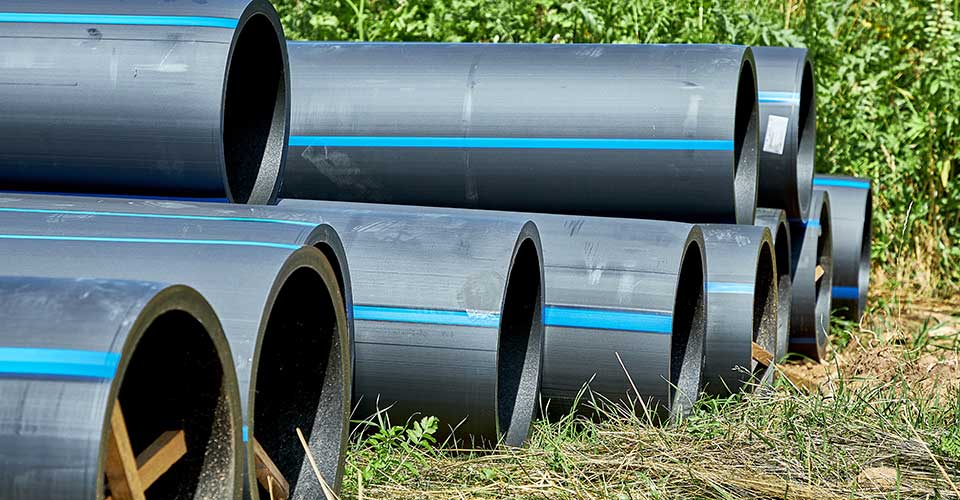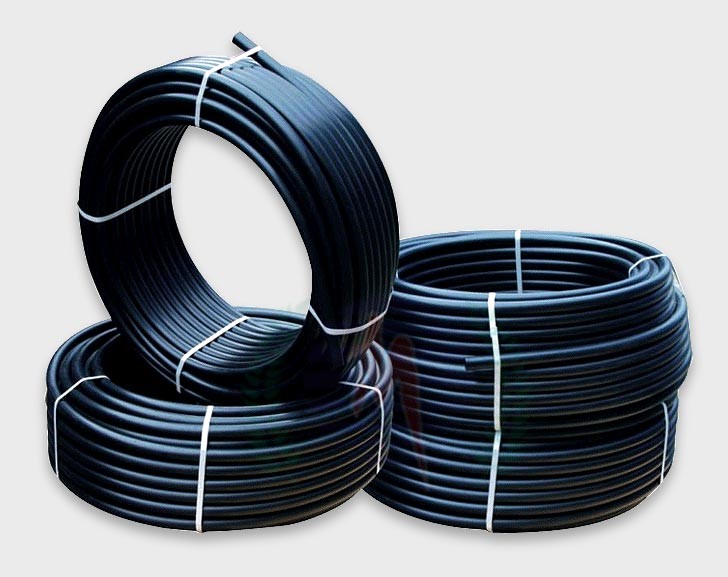Where to Source Midland TX HDPE Pipe Fittings in Stock for Oilfield Success
Explore the Production Refine Behind High-Quality HDPE Pipeline and Its Applications
The manufacturing procedure of top notch HDPE pipes is intricate and systematic. It begins with the option of basic materials that boost performance. Following this, ethylene undertakes polymerization to form resin, which is then formed via extrusion. Quality assurance is vital, guaranteeing that the last product satisfies rigorous requirements. However, the journey of HDPE pipes does not end with manufacturing. Their applications across numerous markets reveal a wider importance worth analyzing.
Recognizing HDPE: Characteristics and Advantages

High-density polyethylene (HDPE) is a versatile polycarbonate known for its resilience and resistance to different ecological elements. This product exhibits exceptional tensile strength, making it suitable for demanding applications. Its low-density structure adds to a lightweight item, assisting in simplicity of dealing with and setup. HDPE also showcases remarkable resistance to chemicals, which minimizes destruction when exposed to extreme compounds.
The product's low wetness absorption better enhances its long life, making it optimal for usage in pipelines and storage containers. Furthermore, HDPE is immune to ultraviolet (UV) radiation, making certain that products keep their stability also when exposed to sunlight. Moreover, its versatility enables the development of elaborate forms without jeopardizing stamina. The environmentally friendly nature of HDPE, often stemmed from recycled products, contributes to its allure, promoting sustainable techniques in manufacturing. On the whole, these properties and advantages make HDPE a recommended option for various industrial and customer applications.
Raw Material Option for HDPE Manufacturing
The option of basic materials for HDPE production is vital to confirm the end product fulfills the desired requirements and top quality requirements. High-density polyethylene (HDPE) is primarily generated from polymerized ethylene, originated from fossil gas such as all-natural gas or petroleum. The top quality of these feedstocks significantly influences the mechanical and thermal residential or commercial properties of the last HDPE.
Additives also play a significant role in enhancing HDPE's performance, consisting of anti-oxidants, UV stabilizers, and colorants, which boost durability and resistance to environmental factors. The selection procedure have to consider not only the chemical structure of the raw materials however additionally their processing attributes to assure efficient production.
Moreover, the sourcing of basic materials need to prioritize sustainability and compliance with ecological guidelines, as accountable techniques are imperative in today's market. Eventually, careful basic material choice lays the structure for producing high-grade HDPE pipelines suitable for diverse applications.
The Extrusion Refine: Shaping HDPE Pipeline
The extrusion procedure plays an essential function fit HDPE pipelines, beginning with thorough product prep work strategies that assure suitable circulation and consistency. Just as vital is the layout of the die, which directly affects the last dimensions and surface area quality of the pipe. Together, these aspects contribute substantially to the effectiveness and quality of HDPE pipeline manufacturing.
Material Preparation Methods
Effective production of HDPE pipelines starts with meticulous product prep work techniques, especially the extrusion procedure. During this stage, high-density polyethylene material is first dried out to get rid of moisture, ensuring perfect circulation attributes. The material is then fed right into the extruder, about his where it undergoes home heating and melting, transforming right into a viscous state. This heating procedure is thoroughly managed to maintain the material's integrity and performance. The molten HDPE is forced through a die, shaping it right into a continual pipeline kind. Correct temperature administration throughout extrusion is crucial, as it straight influences the material's properties and the last item top quality. As soon as formed, the HDPE pipeline is cooled and cut to specified lengths, ready for subsequent processing and applications.
Die Style Importance
Precision in die design plays a vital role in the extrusion procedure of HDPE pipes. The die functions as the last shaping tool, straight affecting the pipe's dimensions, wall density, and surface finish. A properly designed die guarantees uniform material flow, decreasing problems such as irregularities and weak places. The geometry of the die have to be enhanced to accommodate the specific residential or commercial properties of HDPE, including its viscosity and thermal habits throughout extrusion. In addition, the cooling rate of the product as it goes through the die can considerably affect the pipe's architectural integrity. Investing in sophisticated die technology is crucial for suppliers aiming to produce premium HDPE pipelines that meet sector standards and customer assumptions.
Top Quality Control Procedures in HDPE Manufacturing
Different aspects affect the quality of HDPE pipeline production, effective quality control procedures are crucial to ensure uniformity and dependability in the final item (Pipe Supplier American Plastics Midland). Secret quality assurance practices include extensive material evaluation, verifying that the raw polyethylene fulfills well established criteria for pureness and density. During the extrusion procedure, criteria such as temperature level, stress, and cooling time are very closely monitored to maintain dimensional precision and architectural integrity
Furthermore, post-production testing is essential; manufacturers usually perform hydrostatic tests to analyze the pipeline's stamina and resistance to pressure. Visual evaluations for surface area problems even more boost quality assurance. Qualification from appropriate criteria companies, like ASTM or ISO, supplies an added street elbow layer of credibility. By carrying out these thorough top quality control steps, suppliers can reduce issues, improve performance, and ensure that the HDPE pipes meet the certain requirements of different applications, inevitably bring about consumer fulfillment and count on the item.
Applications of HDPE Pipeline Throughout Industries
HDPE pipelines are used throughout numerous sectors due to their longevity and flexibility. In water circulation systems, they guarantee reliable delivery, while in wastewater monitoring, they give reputable services for waste transportation. Additionally, agricultural irrigation networks take advantage of HDPE's resistance to corrosion and versatility, making it a suitable selection for modern-day farming techniques.

Water Circulation Solutions
A significant variety of industries rely on high-density polyethylene (HDPE) pipelines for effective water distribution systems. Understood for their resilience and resistance to rust, HDPE pipes are widely utilized in metropolitan water networks, farming irrigation, and industrial applications. Their light-weight nature facilitates easy handling and installation, minimizing labor expenses and time. In addition, HDPE pipes can fit different pressure degrees, making them appropriate for both low and high-pressure systems. hdpe pipe in stock Midland TX. The adaptability of the material enables smooth integration right into existing facilities, decreasing the requirement for comprehensive excavation. HDPE's resistance to chemical seeping warranties that the water supplied stays safe and tidy, making it an optimal option for preserving the quality of safe and clean water throughout different industries.
Wastewater Management Solutions
Effective water circulation systems additionally lead the method for cutting-edge wastewater monitoring services, where high-density polyethylene (HDPE) pipes play a considerable duty. Distinguished for their longevity and resistance to rust, HDPE pipes are suitable for carrying wastewater in numerous settings. Their adaptability allows for very easy installment in complicated settings, reducing the demand for substantial excavation. Additionally, HDPE's smooth interior surface area reduces rubbing, enhancing flow prices and efficiency. These pipes are additionally resistant to chemical leaching, making sure that impurities do not compromise the surrounding atmosphere. Industries, municipalities, and treatment centers increasingly count on HDPE pipelines for their reliability and durability, making them a favored selection for contemporary wastewater monitoring systems. This versatility emphasizes the vital value of HDPE pipelines throughout numerous applications.
Agricultural Irrigation Networks
Agricultural irrigation networks benefit substantially from making use of high-density polyethylene (HDPE) pipes, which supply reliable and trusted water delivery to crops. HDPE pipelines are light-weight, making them very easy to transfer and set up, while their adaptability permits various setups in varied terrains. These pipes show superb resistance to deterioration, chemicals, and UV radiation, ensuring sturdiness in extreme agricultural settings. In addition, their smooth indoor surface area decreases friction loss, optimizing water flow and decreasing energy costs related to pumping. The longevity of HDPE pipes, frequently surpassing 50 years, adds to lower upkeep and substitute costs. Farmers significantly depend on HDPE pipes to boost watering effectiveness and promote lasting farming practices, inevitably leading to enhanced crop yields and source preservation.

Future Fads in HDPE Pipe Technology
As the demand for lasting and reliable framework expands, advancements in HDPE pipe innovation are positioned to change various markets. Arising trends include the combination of clever innovations, such as sensing units and IoT capacities, which promote real-time surveillance of pipeline problems, lowering maintenance expenses and preventing leaks. In addition, the advancement of innovative manufacturing techniques, such as 3D printing, is enabling the production of complicated, tailored pipe styles that deal with specific project requirements.
Moreover, the concentrate on recycling and circular economy methods is driving the development of HDPE pipes made from recycled materials, improving sustainability. Boosted jointing techniques, such as electro-fusion and mechanical fittings, are additionally enhancing installation performance and dependability. The growing focus on ecological regulations is pressing producers to take on greener production procedures, making sure that HDPE pipes not just meet sector standards but likewise foster an even more sustainable future for framework growth.
Often Asked Questions
Exactly How Does HDPE Contrast to Other Plastic Materials?
HDPE surpasses lots of various other plastic materials pertaining to durability, chemical resistance, and adaptability. Its low thickness and high tensile strength make it suitable for various applications, usually exceeding choices in both performance and durability.
What Are the Ecological Effects of HDPE Manufacturing?
The ecological impacts of HDPE production consist of greenhouse gas emissions, energy intake, and potential contamination from producing go to this website processes. In addition, incorrect disposal can lead to soil and water contamination, increasing worries concerning long-term ecological effects.
Can HDPE Pipeline Be Recycled?
Yes, HDPE pipelines can be reused. Lots of centers approve made use of HDPE for handling, changing it right into brand-new products. This reusing contributes to sustainability efforts, minimizing plastic waste while preserving sources and energy in the manufacturing cycle.
What Is the Life Expectancy of HDPE Piping?

Just How Do Temperature Level Variations Affect HDPE Pipe Efficiency?
Temperature level variations significantly affect HDPE pipe efficiency, influencing adaptability and stamina. Heats can lead to softening, while reduced temperature levels may create brittleness, ultimately affecting the pipe's durability and suitability for different applications in varied atmospheres.